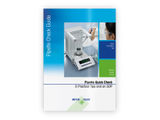To use all functions of this page, please activate cookies in your browser.
my.chemeurope.com
With an accout for my.chemeurope.com you can always see everything at a glance – and you can configure your own website and individual newsletter.
- My watch list
- My saved searches
- My saved topics
- My newsletter
HyperchromicityHyperchromicity is the increase of absorbance (optical density) of a material. The most famous example is a hyperchromicity of a DNA that occurs when DNA duplex is denaturated. The UV absorption is increased when the two single DNA strands are being separated, either by heat or by addition of denaturant or by lowering the pH level. The opposite, a decrease of absorbance is called hypochromicity. Additional recommended knowledgeHeat denaturation of DNA, also called melting, causes the double helix structure to unwind to form single stranded DNA. When DNA in solution is heated above its melting temperature (usually more than 80 oC), the double-stranded DNA unwinds to form single-stranded DNA. The bases become unstacked and can thus absorb more light. In their native state, the bases of DNA absorb light in the 260-nm wavelength region. When the bases become unstacked, the wavelength of maximum absorbance does not change, but the amount absorbed increases by 30-40%. Hyperchromicity can be used to track the condition of DNA as temperature changes. The transition/melting temperature (Tm) is the temperature where the absorbance of UV light is 50% between the maximum and minimum, ie where 50% of the DNA is denatured.
References
Campbell, Mary K. & Farrell, Shawn O. (2006). Biochemistry. Thomson Brooks/Cole.
|
| This article is licensed under the GNU Free Documentation License. It uses material from the Wikipedia article "Hyperchromicity". A list of authors is available in Wikipedia. |






